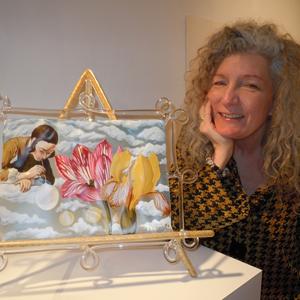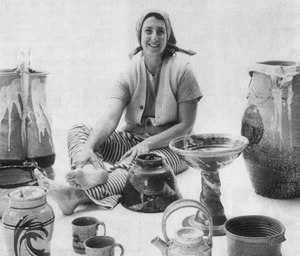Related Research Articles

The New-York Historical Society is an American history museum and library in New York City, along Central Park West between 76th and 77th Streets, on the Upper West Side of Manhattan. The society was founded in 1804 as New York's first museum. It presents exhibitions, public programs, and research that explore the history of New York and the nation. The New-York Historical Society Museum & Library has been at its present location since 1908. The granite building was designed by York & Sawyer in a classic Roman Eclectic style. The building is a designated New York City landmark. A renovation, completed in November 2011, made the building more accessible to the public, provided space for an interactive children's museum, and facilitated access to its collections.

Ginny Ruffner is a pioneering American glass artist based in Seattle, Washington. She is known for her use of the lampworking technique and for her use of borosilicate glass in her painted glass sculptures.
Lowery Stokes Sims is an American art historian and curator of modern and contemporary art known for her expertise in the work of African, African American, Latinx, Native and Asian American artists such as Wifredo Lam, Fritz Scholder, Romare Bearden, Joyce J. Scott and others. She served on the curatorial staff of the Metropolitan Museum of Art, the Studio Museum in Harlem, and the Museum of Arts and Design. She has frequently served as a guest curator, lectured internationally and published extensively, and has received many public appointments. Sims was featured in the 2010 documentary film !Women Art Revolution.

The Museum of Arts and Design (MAD), based in Manhattan, New York City, collects, displays, and interprets objects that document contemporary and historic innovation in craft, art, and design. In its exhibitions and educational programs, the museum celebrates the creative process through which materials are crafted into works that enhance contemporary life.

Elizabeth Woodman was an American ceramic artist.
Malcolm Austin Rogers, CBE is a British art historian and museum administrator who served as the inaugural Ann and Graham Gund Director of the Museum of Fine Arts, Boston, Massachusetts, from 1994 through 2015, the longest serving director in the institution's 150-year history. In this role, Rogers raised the status of the museum locally, nationally, and internationally, and brought both extensive popularity and occasional controversy to the museum.
Judith Schaechter is a Philadelphia-based artist known for her work in the medium of stained glass. Her pieces often use symbolism from stained glass and Gothic traditions, but the distorted faces and figures in her work recall a 20th century German Expressionist painting style and her subject matter is secular. Shaechter's work often involves images that might be considered disturbing such as death, disease, or violence. Early Schaechter pieces, for example, such as King of Maggots and Vide Futentes make use of memento mori, symbols of death found in church architecture during medieval times.
Robert William Ebendorf is an American metalsmith and jeweler, known for craft, art and studio jewelry, often using found objects. In 2003–2004, the Smithsonian American Art Museum organized an exhibition of 95 pieces, titled The Jewelry of Robert Ebendorf: A Retrospective of Forty Years.

Alice Cordelia Morse was an American designer of book covers in the late 19th and early 20th centuries. Her work was inspired by the Arts and Crafts Movement, and she is often placed as one of the top three book designers of her day.
Jonathan Leo Fairbanks is an American artist and expert of American arts and antiques. Fairbanks created the American Decorative Arts and Sculpture department at the Museum of Fine Arts, Boston, and served as Curator of the department from 1970 to 1999.
Thomas Patrick Campbell is the director and CEO of the Fine Arts Museums of San Francisco, overseeing the de Young and Legion of Honor museums. He served as the director and CEO of the Metropolitan Museum of Art between 2009 and 2017. On 30 June 2017, Campbell stepped down as director and CEO of the Metropolitan Museum of Art under pressure and accepted the Getty Foundation's Rothschild Fellowship for research and study at both the J. Paul Getty Museum in Los Angeles and at Waddesdon Manor, in the UK.

Mildred Constantine Bettelheim was an American curator who helped bring attention to the posters and other graphic design in the collection of the Museum of Modern Art in the 1950s and 1960s

The American Federation of Arts (AFA) is a nonprofit organization that creates art exhibitions for presentation in museums around the world, publishes exhibition catalogues, and develops education programs. The organization’s founding in 1909 was endorsed by Theodore Roosevelt and spearheaded by Secretary of State Elihu Root and eminent art patrons and artists of the day. The AFA’s mission is to enrich the public’s experience and understanding of the visual arts, and this is accomplished through its exhibitions, catalogues, and public programs. To date, the AFA has organized or circulated approximately 3,000 exhibitions that have been viewed by more than 10 million people in museums in every state, as well as in Canada, Latin America, Europe, Asia, and Africa.

The Museum of Arts and Crafts in Zagreb, Croatia, was established in 1880, by the initiative of the Arts Society and its former President Izidor Kršnjavi. Drawing on the theoretical precepts of England's Arts and Crafts movement and the intellectual postulates of Gottfried Semper, the museum was devised with the aim of creating a collection of models for master craftsmen and artist to reinvigorate the production of everyday use items. The strategy of the museum's activity was focused on preservation of traditional crafts, as well as creation of a new middle class aesthetic culture. Therefore, in 1882 the Crafts School was founded along the museum. The building, constructed in 1888 by Hermann Bollé, is one of the first purpose-built edifices devised to merge the functions of the museum and the school. Stylistically, the building is a grand historicist palace in the spirit of the German Renaissance.
Paul J. Smith was an arts administrator, curator, and artist based in New York. Smith was professionally involved with the art, craft, and design fields since the early 1950s and was closely associated with the twentieth-century studio craft movement in the United States. He joined the staff of the American Craftsmen's Council in 1957, and in 1963 was appointed Director of the Museum of Contemporary Crafts, a position he held for the next 25 years. In September 1987, he assumed the title of director emeritus and continued to work as an independent curator and consultant for museums, arts organizations, and collectors.

Joyce J. Scott is an African-American artist, sculptor, quilter, performance artist, installation artist, print-maker, lecturer and educator. Named a MacArthur Fellow in 2016, and a Smithsonian Visionary Artist in 2019, Scott is best known for her figurative sculptures and jewelry using free form, off-loom beadweaving techniques, similar to a peyote stitch. Each piece is often constructed using thousands of glass seed beads or pony beads, and sometimes other found objects or materials such as glass, quilting and leather. In 2018, she was hailed for working in new medium — a mixture of soil, clay, straw, and cement — for a sculpture meant to disintegrate and return to the earth. Scott is influenced by a variety of diverse cultures, including Native American and African traditions, Mexican, Czech, and Russian beadwork, illustration and comic books, and pop culture.
Mahrukh Tarapor is an Indian museum professional and art consultant, known for her scholarship in museum art, especially Islamic art. She was honoured by the Government of India, in 2013, by bestowing on her the Padma Shri, the fourth highest civilian award, for her contributions to the field of art.
Linda Threadgill is an American artist whose primary emphasis is metalsmithing. Her metal work is inspired by forms of nature and the interpretations she gleans from the intricate patterns it presents. She explores the foundation of nature to allude to nature and transform it into re-imagined, stylized plants forms.
Glenn Adamson is an American curator, author, and historian whose research and work focuses on the intersections of design, craft, and contemporary art. Adamson is currently editor-at-large of The Magazine Antiques, editor of Journal of Modern Craft, a freelance writer and a curator. Adamson has held previous notable appointments as the Director of the Museum of Arts and Design, Head of Research at the Victoria and Albert Museum, and as Curator at the Chipstone Foundation.
Nanette L. Laitman was an art collector and philanthropist. She has been involved with the board of the Museum of Arts and Design (MAD) and its precursors in New York City for over 25 years. She became a member of the board in 1994 and board president in 2000. She was one of the main benefactors supporting MAD's relocation to 2 Columbus Circle in 2002. Laitman has also funded the Nanette Laitman Documentation Project for Craft and Decorative Arts in America at the Smithsonian's Archives of American Art.